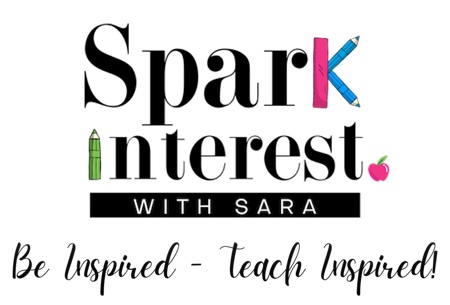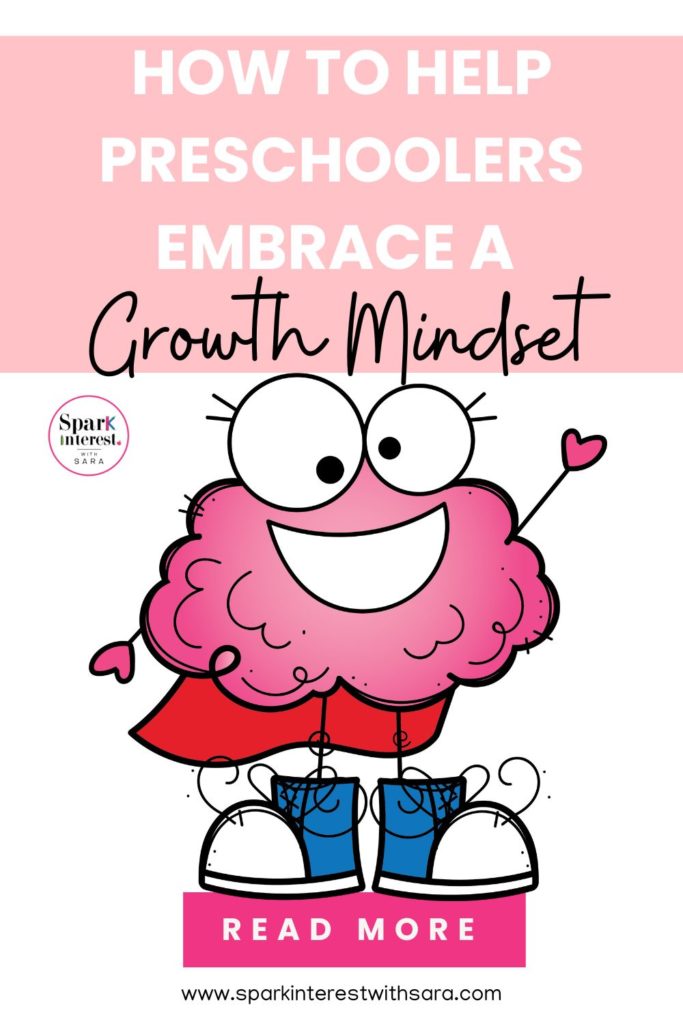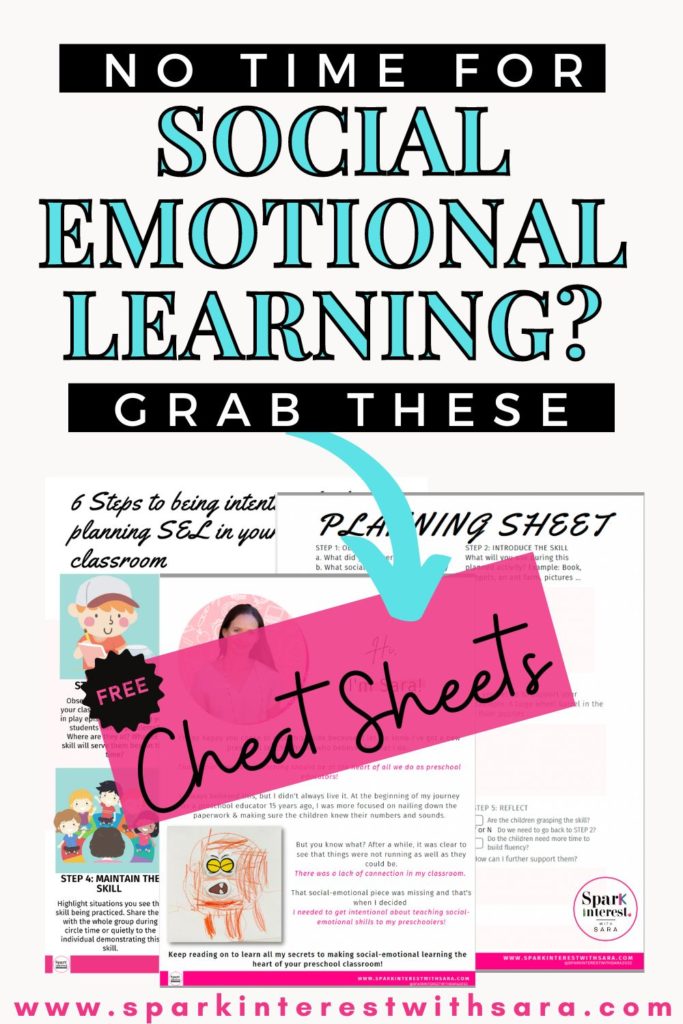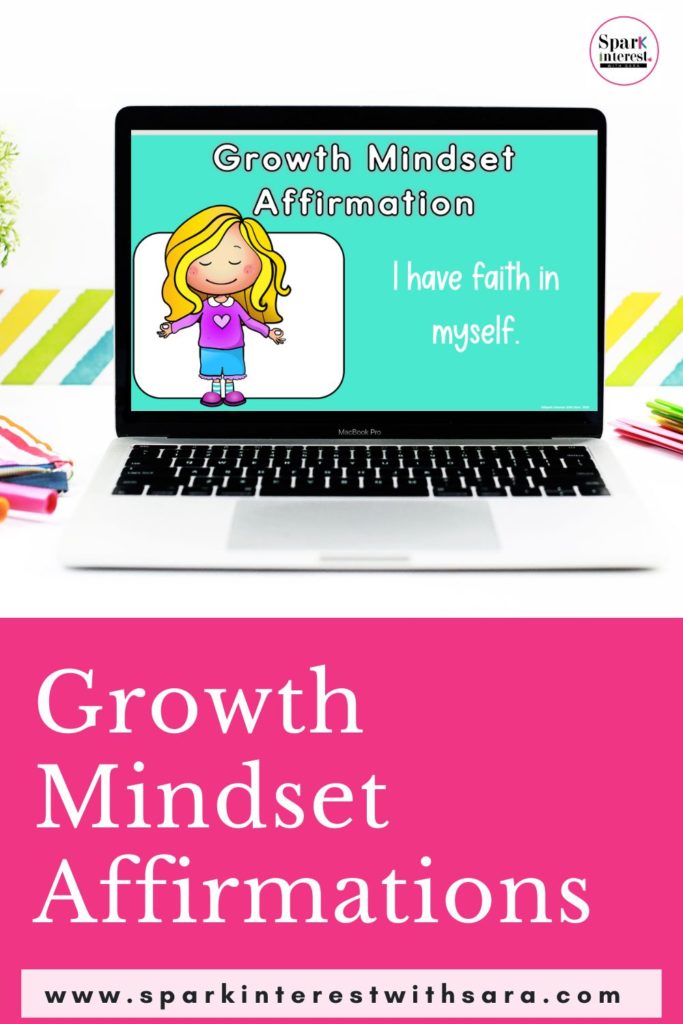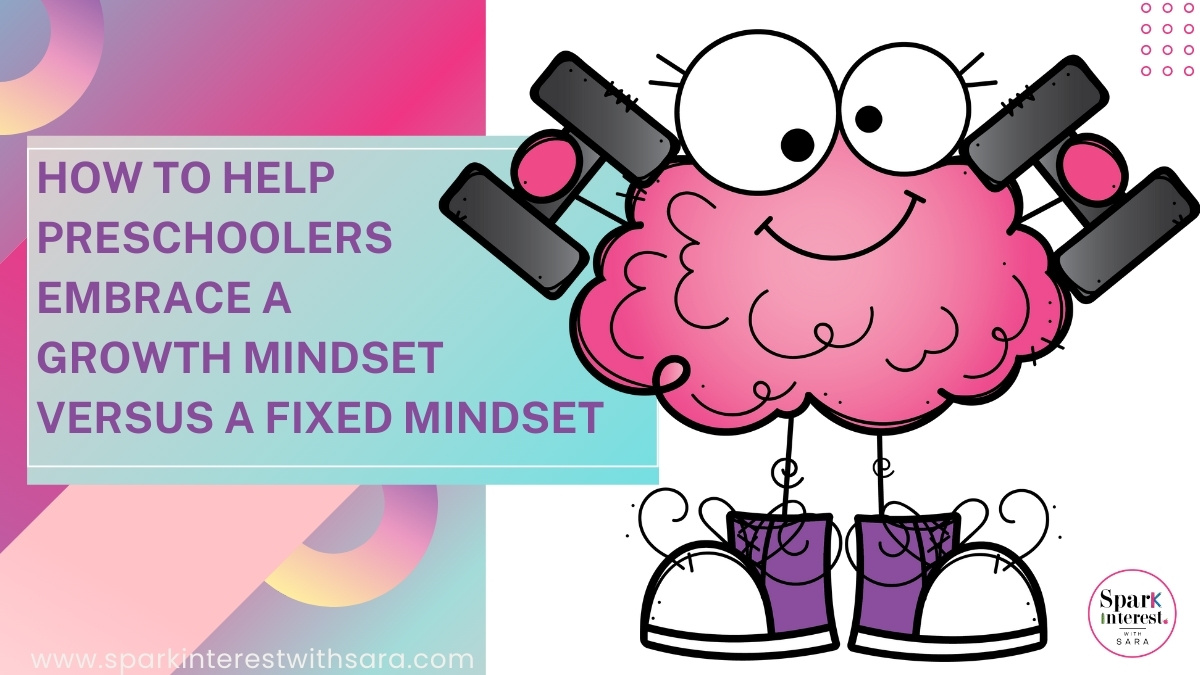
“I can’t do it!” or “I can’t do it…yet!” Which of these phrases have you heard more in your preschool classroom? Just by adding that 3 letter word at the end, ‘YET’ we can begin to help our students embrace a growth mindset versus a fixed mindset.
This simple phrase lets your little learners know that it’s okay to struggle and not know something, it allows them to learn something new and continue to try even when it’s challenging, and it gives them hope that they will be able to do the difficult task soon.
Opening our classroom up and asking our students to have a growth mindset can sometimes be challenging at the preschool level. Students are learning so much, and with that comes frustration. But teaching them exactly how to stay in a growth mindset can help!
Before I jump in to sharing how to help our students develop a growth mindset, I wanted to make sure you’ve gotten your hands on my free guide and planning sheet to get yourself started when it comes to integrating Social Emotional Learning into your preschool classroom. This super useful planning sheet will make it easy to link your SEL lessons to what is actually happening in your classroom! You will be able to easily respond to the needs of your students and seamlessly integrate SEL into your day. Who doesn’t want that? If you do, click on the image to download it.
What’s Growth Mindset?
Dr. Carol Dweck, a Stanford professor and one of the founders of the idea that humans have two different types of mindsets, explains that we all have either a “growth” or “fixed ” mindset. She defines the “growth mindset” as the core belief in your abilities and that you can develop intelligence through hard work and trial and error.
She also goes on to say that a “fixed mindset” is where intelligence is inherent and cannot be developed. A child who believes that they are not good at something and that they will never be good at it because their brain just “doesn’t get it.” I’m sure you can see how talking to themselves in that way can create many blocks to learning.
That’s why we want to keep our little learners in the growth mindset bubble. We want them to develop and grow as they work on difficult tasks and problems.
Some growth mindset characteristics are:
- Learning from failure
- Belief in oneself
- Positivity
- Resilience and perseverance
- Excitement for challenges
Growth Mindset vs. Fixed Mindset Examples
I have witnessed many examples of both a growth mindset and a fixed mindset from my years in the preschool classroom, as I’m sure you have too. It’s hard not to when children come in so little and are learning so many things, and they are expected to walk out of the classroom at the end of the year doing so many more things. If you still aren’t sure what this looks like, here are two examples of growth mindset versus fixed mindset that will demonstrate how it relates to our little learners.
Growth Mindset Example
Joy is working on her letter formation and determining the name and sound that each letter makes. At the beginning of the year, she couldn’t recognize letters or write any of them. She struggled whenever we worked on letters and seemed to be discouraged at times. However, Joy sang the alphabet song whenever possible, worked at the letter station during center time often, and happily worked with the teacher in small groups to practice letters. By the end of the year, Joy knew her letters. She may not know every sound, but she kept a growth mindset.
Fixed Mindset Example
Layla is also working on her letter formation, determining the names and the sounds of each letter like Joy was. At the beginning of the year, she was much like Joy and couldn’t recognize letters or write any. She struggled in circle time to practice with the rest of the class and would often just sit quietly when the alphabet song came on or as the class repeated letters. Layla often said, “I don’t like letters,” or “I’m never going to learn any letters.” Whenever she went to centers, she stayed clear of the letter center. During small groups, she often said: “I’m not doing this.” and refused to participate. At the end of the year, Layla only knew a handful of letters.
Joy and Layla are imaginary students, but the situations above are very common in the preschool classroom. You have probably had (or have) Joy and Layla in your classroom. Helping students develop and stay in a growth mindset will make a world of difference!
Why Growth Mindset Matters
When you work to keep students in a growth mindset, you are setting them up for success in the classroom and in their personal lives as well.
Lifelong Love of Learning
With a growth mindset, students are often more open to new information and learning in the future. They achieve things through hard work and are more likely to dig deeper for knowledge, try new things and experiment with ideas. They will begin to understand the importance of persistence and determination.
If we want to change the way we learn, we have to change the way we think. Being aware that talents and intelligence can be developed will allow our students to see that they can learn anything! That is a vital mindset to have, because this gives us the freedom to explore, experience and achieve more in life.
Ability to Evolve Outside the Classroom
When students have a growth mindset, it doesn’t just disappear when they leave preschool or the classroom in general. If they are in a constant state of growth, they will be more well-rounded outside of school. They understand how the process of trial and error works and will use it to grow in their personal lives. Just think about a child learning to ride a bike, create using clay or learn to play the piano; a growth mindset will be an asset in developing these skills.
Key Ways to Help Your Students Shift Towards a Growth Mindset
Now that you have the why’s, I want to give you some practical ways you can begin to integrate a growth mindset in your preschool classroom. Here are some super simple ways you can begin to help your young learners shift into a growth mindset!
1. Use Growth Mindset Videos and Books
Preschoolers love watching videos and reading books together. Use this to your advantage and find some of each that help teach a growth mindset and allow your students to see it in action. There’s nothing like a discussion that comes from a quality picture book or a fun catchy YouTube video to get your students thinking and talking about what it means to have a growth mindset.
Videos about Having a Growth Mindset
Class Dojo is not only a great classroom management tool, but they have a great growth mindset video series that is easy for students to understand and has some great characters!
Gromo and friends is another great resource. With two videos, they talk about the “power of yet” and how we want to focus on depth over speed!
This video uses a seed as an example and is 100% relatable to preschoolers. They’ll watch as the seed continues to stay in a growth mindset and eventually grows into a beautiful plant.
This catchy tune and fun brain break all about the power of yet, can be used in the classroom, and will get your children motivated and ready to learn.
Books about Developing a Growth Mindset versus Fixed Mindset
- The Power of Yet By Maryann Cocca-Leffler
A great book that helps students see that it’s ok not to be able to do something yet. This little pig is trying to learn exactly how to conquer frustration even when he can’t do everything he thinks he can!
- Growth Mindset Ninja By Mary Nhin
A wonderful read that helps students learn about growth mindset versus fixed mindset: it helps students develop valuable life skills and is fun and entertaining for this preschool age group.
- Beautiful OOPS! By Barney Saltzberg
A book that helps students (and adults) learn that it is ok to make mistakes, and sometimes a little mistake may turn into a beautiful piece of art!
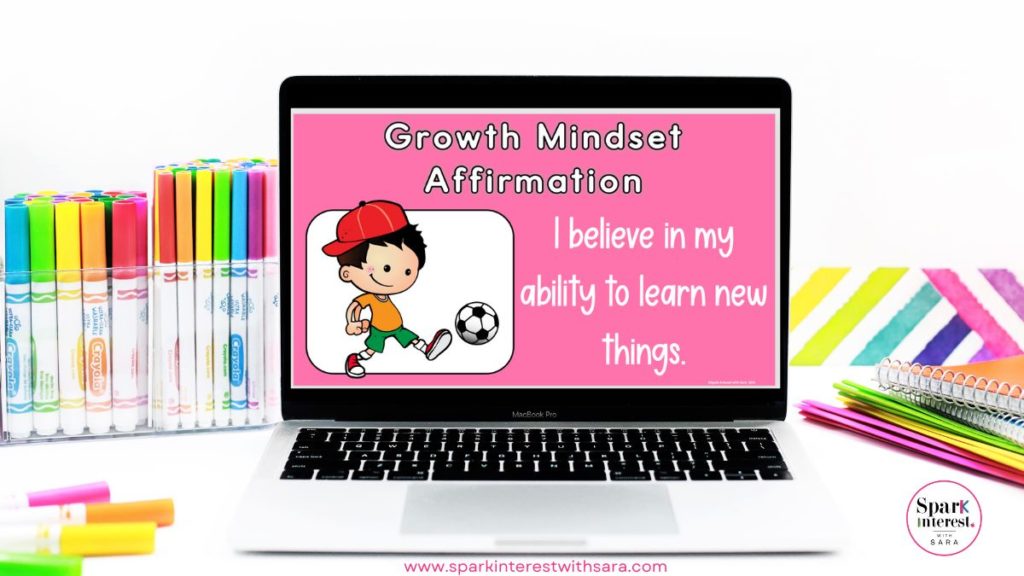
This positive self talk can increase confidence, overall well-being, enhance self-esteem and most importantly teach children a valuable tool to support themselves.
2. Introduce Growth Mindset Affirmations In The Classroom
There are many ways to introduce growth mindset affirmations in your classroom. You may start by including them in different places throughout your day. Some of these places may include:
- Morning Line Up
- Morning Meetings
- Afternoon Lineup
- Before Certain Subjects or Activities
- Create an Affirmation Station
3. Highlight Real Life Examples of Growth Mindset
A great way to help students understand exactly what a growth mindset looks like is to notice and highlight students who are displaying a growth mindset. You may give them process praise which is when you praise the process they took to finish their work or accomplish a task.
You may say something like, “I can see how much effort you put in and how much you have improved.” or “You really looked at your old worksheet and tried to find ways to improve your work.”
Whether you choose to highlight students, create a beautiful growth mindset affirmation station, or have students repeat growth mindset affirmations throughout the day, allowing for positive self awareness and self talk activities will benefit them in the long run!
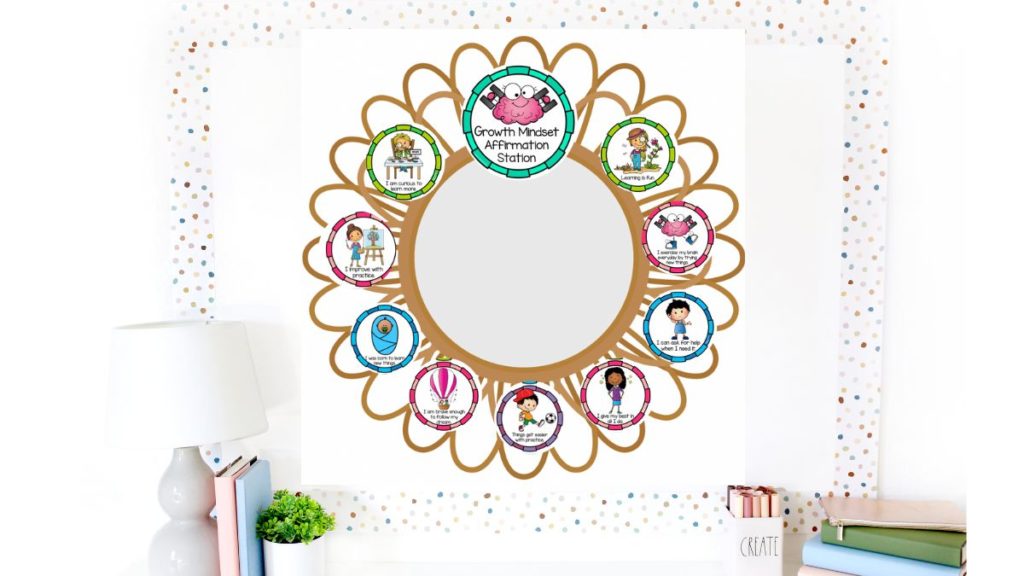
Growth Mindset Versus Fixed Mindset
A growth mindset is a great way to get students thinking about their learning behavior and how they can improve. Figuring out ways to give students growth mindset opportunities will not only help them become better students and people but will help your classroom blossom!
Want more ideas on supporting Social Emotional Development in your Preschool Classroom? Check out the blog posts below:
???????? How to support SEL in Preschool
???????? 50 Social Emotional Development in Early Childhood Books
Let's Connect:

Sara
